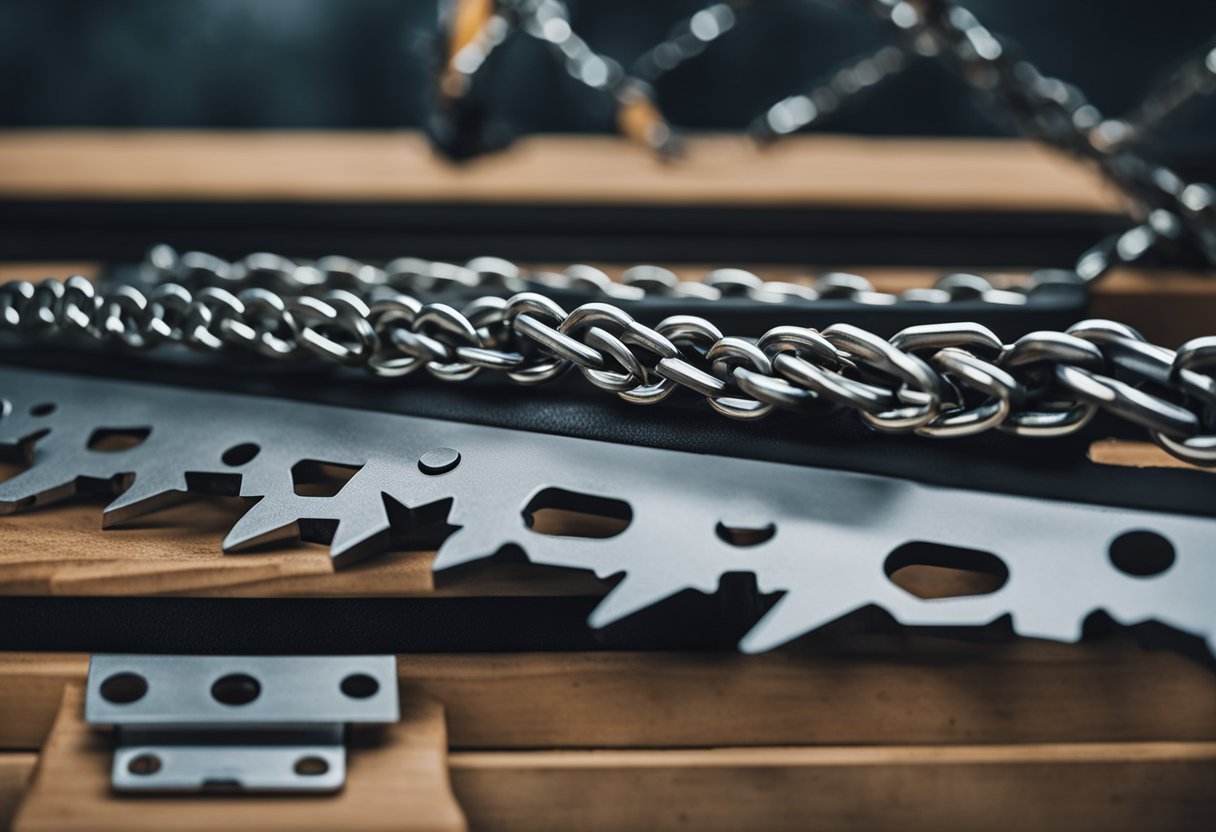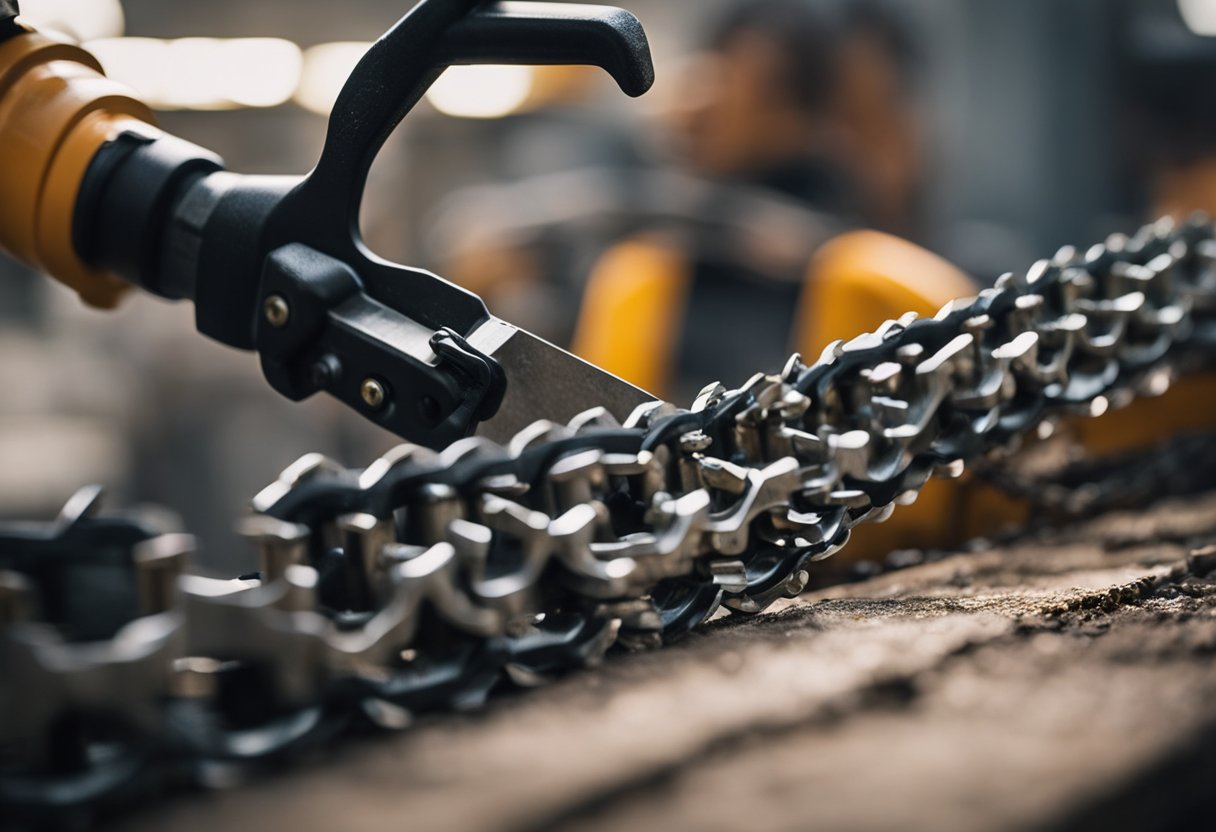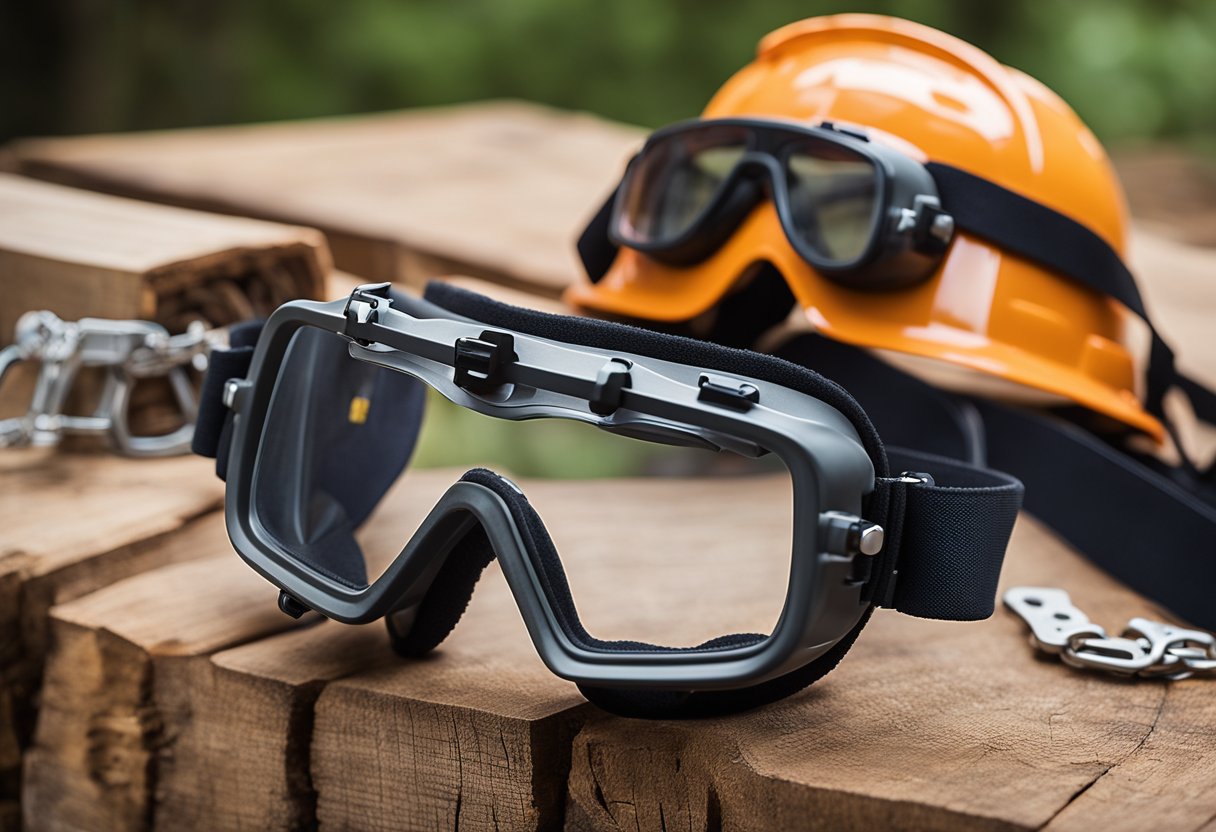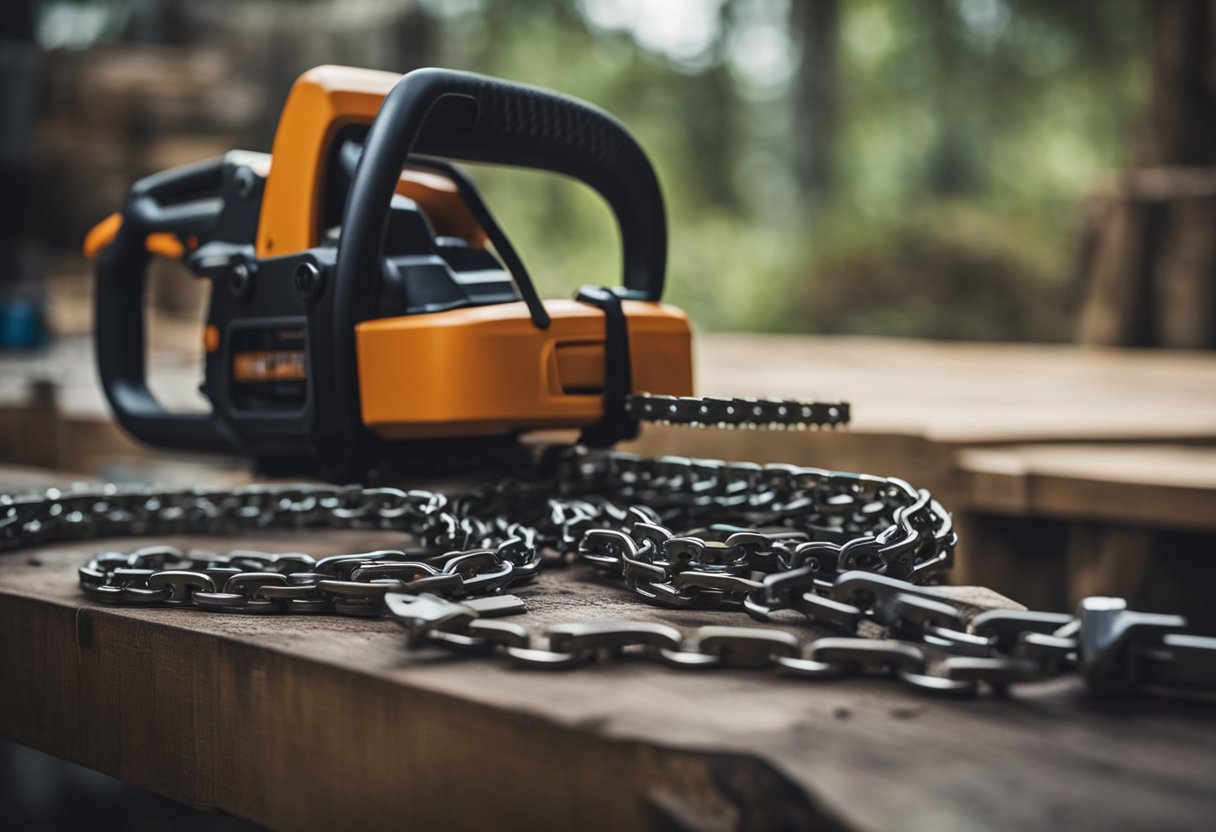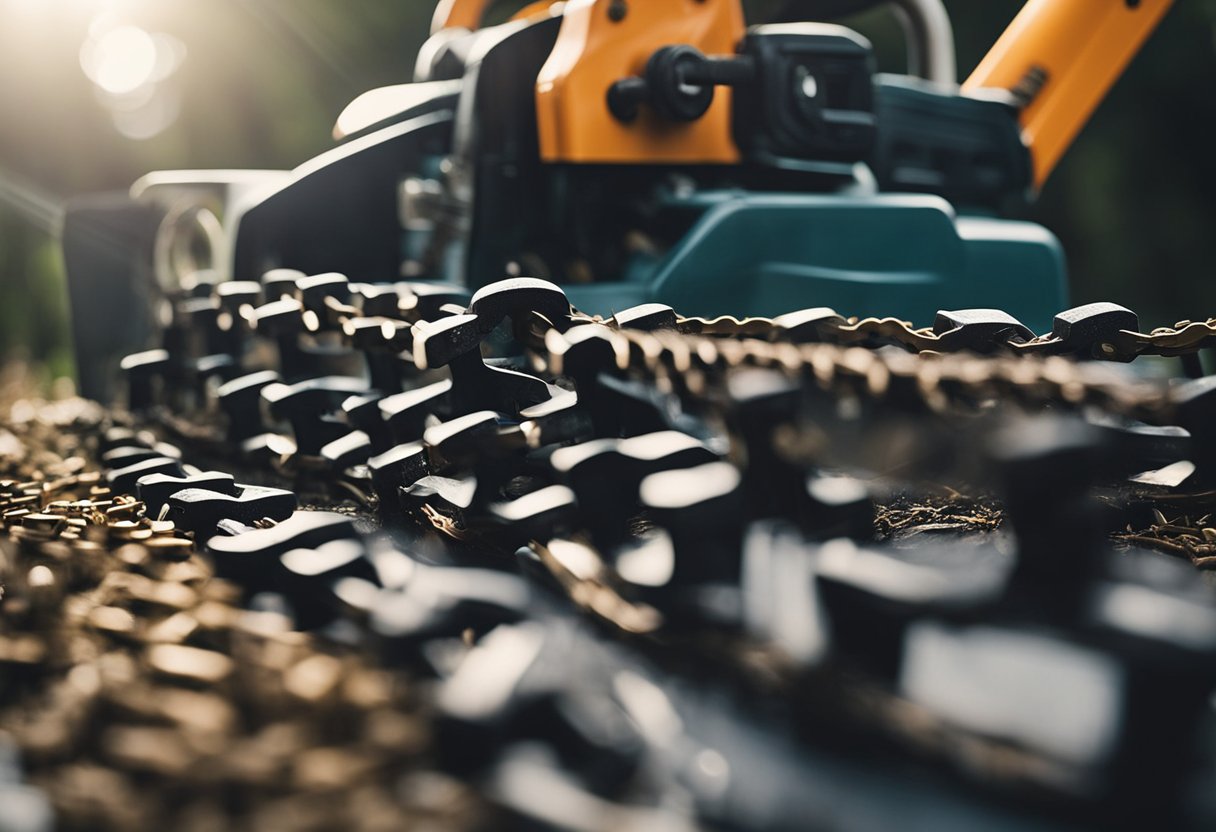Shortening a chainsaw chain can be a daunting task, but it is a necessary one if you want to keep your chainsaw in good working order. A chainsaw chain that is too long can be dangerous and cause accidents, while a chain that is too short can damage your chainsaw. In this article, I will guide you through the process of shortening a chainsaw chain step by step, from understanding chainsaw chains to maintaining the correct chain length.
To start, it is important to understand the anatomy of a chainsaw chain. A chainsaw chain is made up of a series of links, each of which has two cutting teeth. The links are connected by rivets, which can be removed to shorten the chain. However, it is important to note that not all chains can be shortened, so be sure to check your chainsaw manufacturer’s instructions before attempting to shorten the chain.
Before you begin shortening your chainsaw chain, there are a few tools you will need. These include a chainsaw file, a chain breaker, and a rivet spinner. You will also need to take some safety precautions, such as wearing protective gear and ensuring that the chainsaw is turned off and the chain brake is engaged. With the right tools and safety measures in place, you can successfully shorten your chainsaw chain and keep your chainsaw in good working order.
Key Takeaways
- Understanding the anatomy of a chainsaw chain is important before attempting to shorten it.
- Required tools for shortening a chainsaw chain include a chainsaw file, chain breaker, and rivet spinner.
- Safety precautions and maintaining the correct chain length are crucial for maintaining a safe and functional chainsaw.
Understanding Chainsaw Chains
https://www.youtube.com/watch?v=iY-qgN6StuQ&embed=true
As a chainsaw user, it is essential to understand the different components of a chainsaw chain. A saw chain is a critical part of the chainsaw, responsible for cutting through wood, metal, and other materials.
Types of Chainsaw Chains
There are different types of chainsaw chains, including full chisel, semi-chisel, and low-profile chains. Full chisel chains are more aggressive and have sharp, square-cornered teeth that cut through wood quickly. Semi-chisel chains have rounded teeth that are less aggressive but last longer than full chisel chains. Low-profile chains are designed for smaller chainsaws and have fewer teeth, making them less aggressive but more efficient.
Chain Pitch
Chain pitch refers to the distance between the drive links on the chain. It is essential to know the chain pitch of your chainsaw before purchasing a new chain. The most common chain pitches are ¼ inch, ⅜ inch, and .325 inch.
Drive Links
Drive links are the part of the chain that sits in the guide bar’s groove and engages with the chainsaw’s sprocket. It is essential to know the number of drive links on your chainsaw chain before purchasing a new one.
Teeth
Teeth are the part of the chain that cuts through wood. The number of teeth on a chainsaw chain depends on the chain’s length and pitch. Chains with more teeth make smoother cuts but are less aggressive than chains with fewer teeth.
Tie Straps
Tie straps are the parts of the chain that hold the cutting teeth in place. They are made of metal and are located between the cutting teeth.
Master Link
The master link is the link that connects the two ends of the chainsaw chain together. It is essential to know where the master link is located on your chainsaw chain before attempting to shorten it.
Understanding the different components of a chainsaw chain is essential to maintain and replace the chain correctly. By knowing the chain pitch, drive links, teeth, tie straps, and master link, you can purchase the right chain for your chainsaw and shorten it to the desired length.
Required Tools for Shortening
To shorten a chainsaw chain, you will need a few tools. Here are the tools you need:
-
Wrench: A wrench is required to loosen the nuts that hold the chainsaw bar in place. You will need to remove the chainsaw bar to access the chain.
-
Pliers: Pliers are used to remove the chain from the chainsaw bar. You will need to use pliers to remove the retaining clip that holds the chain in place.
-
Chain breaker: A chain breaker is a special tool that is used to break the chain. The chain breaker pushes the pins out of the chain links, allowing you to remove links from the chain.
-
Chainsaw file: A chainsaw file is a tool that is used to sharpen the teeth on the chainsaw chain. You may need to sharpen the teeth on the chain after you have shortened it.
-
Flat file: A flat file is used to file down the rivets on the chain links after you have removed links from the chain.
When you have all the required tools, you can start shortening your chainsaw chain. Make sure you have a clear workspace and follow all safety precautions before you begin.
Safety Precautions Before Shortening
Before shortening a chainsaw chain, it is important to take certain safety precautions to prevent any accidents or injuries. As someone who has worked with chainsaws before, I always make sure to follow these precautions to ensure my safety.
Firstly, I always make sure to turn off the chainsaw and disengage the chain brake before attempting to shorten the chain. This prevents the chain from accidentally moving and causing any harm.
Additionally, I wear protective gear such as safety gloves and safety goggles to protect my hands and eyes from any debris. It is also important to wear appropriate clothing that covers your body to avoid any injuries.
When shortening the chain, I use a hammer and punch to remove the drive links or file down the teeth. It is important to use these tools carefully and with precision to avoid any accidents.
In summary, before shortening a chainsaw chain, make sure to turn off the chainsaw, disengage the chain brake, wear protective gear, and use the appropriate tools carefully and with precision. By following these safety precautions, you can ensure your safety while working with a chainsaw.
Steps to Shorten a Chainsaw Chain
https://www.youtube.com/watch?v=ZyD-KlJfz3k&embed=true
As a chainsaw user, I understand the importance of maintaining the correct chain length for optimal performance. An incorrect chain length can lead to poor cutting performance and even damage to the chainsaw. In this section, I will guide you through the steps to shorten a chainsaw chain.
Step 1: Measure the Chain Length
Before you begin shortening the chain, you need to know the correct length of the chain required for your chainsaw. To measure the chain length, you can count the number of drive links on the chain or refer to your chainsaw’s user manual.
Step 2: Remove the Chain
To shorten the chainsaw chain, you need to remove it from the chainsaw. Start by releasing the chain tension and removing the side cover with a wrench. Once the cover is removed, take off the nuts or bolts that hold the chain in place.
Step 3: Shorten the Chain
Using a chain-breaking tool, remove the required number of links from the chain. Be careful not to damage the chain rivets during this process. Once the chain is shortened, use the snap test to ensure that the chain is properly tensioned.
Step 4: Reattach the Chain
After shortening the chain, reattach it to the chainsaw. Make sure that the chain is properly aligned and tensioned. You can adjust the chain tension using the push arm on your chainsaw.
By following these steps, you can easily shorten a chainsaw chain to the required length. Remember to always measure the chain length before removing it from the chainsaw, and be careful not to damage the chain rivets during the shortening process.
Maintaining the Correct Chain Length
https://www.youtube.com/watch?v=lp_qitXWHT0&embed=true
As a chainsaw owner, it is essential to maintain the correct chain length to ensure optimal performance and safety. A chainsaw chain that is too long can cause the chainsaw to overwork and may even lead to kickback, while a chain that is too short can cause the chainsaw to malfunction and damage the bar.
To maintain the correct chain length, you should regularly check the tension of the chain. A loose chain can cause the chain to come off the bar and potentially cause injury. On the other hand, an overly tight chain can cause damage to the chainsaw’s bar and chain, leading to costly repairs.
To check the tension of the chain, turn off the chainsaw and use a wrench to loosen the nuts that hold the bar in place. Then use a screwdriver to adjust the tension screw until the chain is snug against the bar but can still be moved by hand. Finally, tighten the nuts and check the tension again to ensure it is correct.
One common mistake that many chainsaw owners make is neglecting to check the tension of the chain regularly. It is recommended to check the chain tension every time you use the chainsaw and to adjust it if necessary.
In summary, maintaining the correct chain length is crucial for optimal chainsaw performance and safety. By regularly checking the chain tension and making adjustments as needed, you can ensure that your chainsaw operates smoothly and safely.
Chainsaw Maintenance Post Shortening
After shortening a chainsaw chain, it is essential to maintain the chainsaw to ensure optimal performance and longevity. Here are some tips on chainsaw maintenance post shortening:
Check the Sprocket
Before using the chainsaw, it is essential to check the sprocket. The sprocket is the small gear that drives the chain around the bar. If the sprocket is damaged or worn out, it can cause the chain to slip or break. Check the sprocket for any signs of wear or damage, and replace it if necessary.
Tighten the Bolts
Check the bolts that hold the chainsaw together, including the bar bolts, chain tensioning bolts, and engine mounting bolts. Tighten any loose bolts to ensure that the chainsaw is secure and safe to use.
Check the Oiler
The oiler is responsible for lubricating the chain and bar, reducing friction and preventing wear. Check the oiler to ensure that it is working correctly. If the oiler is clogged or not working correctly, it can cause the chain to overheat and break. Clean or replace the oiler if necessary.
Repair Rivets
If your chainsaw chain has broken or damaged rivets, it is essential to repair or replace them. Damaged rivets can cause the chain to break, which can be dangerous. Use repair rivets to fix any damaged rivets, or replace the chain if necessary.
By following these tips, you can ensure that your chainsaw is in top condition after shortening the chain. Regular maintenance can extend the life of your chainsaw and keep it running smoothly.
Pruning and Other Uses of Shortened Chains
https://www.youtube.com/watch?v=cN8zV-Ucsw4&embed=true
When it comes to pruning, a shortened chainsaw chain can be a lifesaver. Pruning is the process of trimming trees, bushes, and hedges to keep them healthy and well-groomed. With a shortened chainsaw chain, pruning becomes easier and more precise. You can trim branches and stems with more accuracy, and the chain is less likely to get stuck in the wood.
Shortened chainsaw chains are also useful for other tasks besides pruning. For example, if you need to cut firewood for your fireplace or wood stove, a shorter chain can make the job easier and safer. A shorter chain is also beneficial when cutting smaller trees or shrubs, as it allows you to maneuver the chainsaw more easily.
To ensure that your shortened chainsaw chain is safe and effective for pruning and other tasks, it’s important to follow the proper steps for shortening the chain. Always use a reliable guide or tutorial, such as those found in the search results. Also, make sure to wear protective gear, such as gloves and goggles, to prevent injury.
In summary, a shortened chainsaw chain can be a valuable tool for pruning and other tasks. By following the proper steps for shortening the chain and using protective gear, you can make your chainsaw safer and more effective for a variety of cutting tasks.
Frequently Asked Questions
What is a pocket chain breaker and how does it work?
A pocket chain breaker is a small tool that is used to break chainsaw chains. It is designed to be lightweight and portable, making it easy to carry with you wherever you go. To use a pocket chain breaker, you first need to locate the chain link that you want to remove. Then, you place the chain in the tool and turn the handle to break the link. This tool is very useful for those who need to make quick repairs on their chainsaw chain while out in the field.
What is the best chainsaw chain breaker and spinner?
There are many different types of chainsaw chain breakers and spinners available on the market. Some of the best ones include the Oregon Bench-Mount Chain Breaker, the Oregon Professional Bench-Mount Chain Spinner, and the Stihl Chainsaw Chain Breaker and Spinner. These tools are all designed to be durable and easy to use, making them great choices for those who need to work on their chainsaw chains frequently.
How do I use a chainsaw chain rivet tool?
To use a chainsaw chain rivet tool, you first need to remove the damaged link from your chain. Then, you place the new link into the tool and use the tool to press the rivet into place. This will securely attach the new link to the rest of the chain. It is important to use the correct size rivet for your chain, as using the wrong size can cause the chain to break.
Can I put a smaller chain on my chainsaw?
No, you should never put a smaller chain on your chainsaw. Using a smaller chain can cause the chain to break or the chainsaw to malfunction. Always use the correct size chain for your chainsaw to ensure that it operates safely and efficiently.
How do I prevent my chainsaw chain from stretching?
To prevent your chainsaw chain from stretching, you should always keep it properly lubricated. You should also avoid using the chainsaw for extended periods of time without giving it a break. Additionally, you should always use the correct size chain for your chainsaw, as using the wrong size can cause the chain to stretch and break.
What is a chainsaw chain master link and how do I install it?
A chainsaw chain master link is a special link that is used to connect the two ends of a chainsaw chain. To install a master link, you first need to remove the damaged link from your chain. Then, you place the master link into the chain and use a chain rivet tool to secure it in place. It is important to use the correct size master link for your chain, as using the wrong size can cause the chain to break.

Hi, I’m Sal Muller of Tooltrip.com. My DIY experience led me to understand essential power tools for home projects. Tooltrip.com guides enthusiasts and professionals in choosing right tools for any job. I provide concise top tool reviews for easier, efficient DIY.

